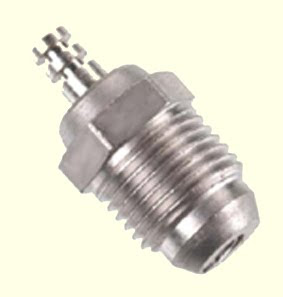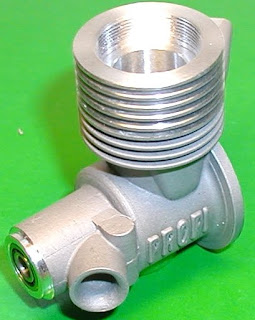The technology of glo

w plugs escapes most of us. Sure, we all know that our nitro engines need them to start and to run, but beyond that, we don't know much. Glow plugs are, in fact, a critical part of the whole performance picture.
A glow plug is the ignition system for your nitro-powered vehicle. Instead of a spark-ignition system such as those found in models airplanes engines, the remarkably simple glow plug is what we use to ignite the fuel in our engines. It doesn't have a single moving part or adjustment; its only functioning component is a simple, stationary coil of wire.
A la derecha una clasica bujia K&B  de los años 50´s
de los años 50´sA la izquierda una moderna bujia
convencional
HOW DOES IT WORK?Starting an engine is one of the functions of a glow plug. When a glow igniter is attached to a glow plug, it causes the glow plug's coil to "glow" white-hot. This ignites the air/fuel mixture in the cylinder when the engine is started. Once the engine is running, the heat generated during compression and combustion keeps the glow plug's element hot enough to continue igniting the fuel mixture on its own without the help of an external power source. In the simplest terms possible, that's how a glow plug works.
WHAT IS A TURBO PLUG? Glow plugs are available in two configurations: standard and turbo. Most engines come with a standard plug. They feature a straight, threaded housing that threads through the cylinder head into the combustion chamber. Turbo plugs feature a different type of housing; the end that goes into the combustion chamber is tapered. The tapered end mates with a head that is specially designed for use with turbo plugs. The head is also tapered to accept this type of plug. The supposed advantages are less compression leakage around the glow plug and less disruption of the combustion chamber. The hole in the cylinder head that exposes the glow plug to the air/fuel mixture in the cylinder is much smaller, and there are fewer rough edges to create unwanted hot spots.

A la derecha un ejemplo
de una bujia turbo
WHICH TYPE OF GLOW PLUG SHOULD I USE?OK; you've blown the glow plug that was included with your engine, so it's time to get a new one. Which one do you buy? You could try to find the same plug, if information about its brand and type was included with your engine. More likely, you will have to choose from the brands and types of plugs that are available at your local hobby shop.
What makes the subject of choosing a glow plug a little confusing is the variety of types that are available. Each manufacturer offers a range of plugs, from as few as three or four up to 10 or more. A plug is usually identified by a code that indicates its effective operating temperature; not the operating temperature of the engine or the outside air, but the relative temperature of the glow plug's coil. Each manufacturer has its own unique temperature-rating system, and general application recommendations are sometimes included to try to steer consumers toward the correct plugs for their needs.
The process can be confusing, however, because a universal rating system does not exist for glow plugs. For example, an O.S. R5 plug is not the same as a McCoy MC-9, although both are considered "cold" plugs. A glow-plug manufacturer's guidelines will suffice for average enthusiasts who simply want their boats to run; racers and performance buffs, however, won't get the most out of their engines without a little experimentation. So what should you look for in a replacement plug?
Some general rules about plugs are determined by the size of the engine and the type of fuel used. Smaller engines usually require hotter plugs, while larger engines favor cooler plugs. Engines that run fuel containing a high percentage of nitro favor the cooler plugs as well, while those that run on less nitro prefer hotter plugs (nitro fuels for car engines typically include 10 to 40 percent nitromethane). For example, a small, .12ci (2.1cc) engine that burns highnitro fuel would favor a warm plug in a mid-range temperature (small engine = hotter plug; high-nitro fuel = colder plug). The same plug might also be suitable for a .21ci (3.5cc) engine running low-nitro fuel (large engine = colder plug; lownitro fuel = hotter plug).
A la Izquierda
primer plano de una bujia turboThe size of your engine and the ty

pe of fuel are easy enough to determine, so these guidelines should get you pointed in the right direction. For racing buffs who want to get maximum ponies, however, another element that's not easily determined-yet should be taken into consideration-is compression ratio. The compression ratio of an engine will also be a factor in choosing the proper plug. High-compression engines favor colder plugs, while those with lower compression favor hotter plugs. Engine manufacturers rarely disclose an engine's compression ratio, so it may be difficult to use this information to select plugs unless you know how to calculate compression or can measure it with a compression gauge.
Note: turbo plug only fit heads designed for this type of plug.





 w plugs escapes most of us. Sure, we all know that our nitro engines need them to start and to run, but beyond that, we don't know much. Glow plugs are, in fact, a critical part of the whole performance picture.
w plugs escapes most of us. Sure, we all know that our nitro engines need them to start and to run, but beyond that, we don't know much. Glow plugs are, in fact, a critical part of the whole performance picture.

 pe of fuel are easy enough to determine, so these guidelines should get you pointed in the right direction. For racing buffs who want to get maximum ponies, however, another element that's not easily determined-yet should be taken into consideration-is compression ratio. The compression ratio of an engine will also be a factor in choosing the proper plug. High-compression engines favor colder plugs, while those with lower compression favor hotter plugs. Engine manufacturers rarely disclose an engine's compression ratio, so it may be difficult to use this information to select plugs unless you know how to calculate compression or can measure it with a compression gauge.
pe of fuel are easy enough to determine, so these guidelines should get you pointed in the right direction. For racing buffs who want to get maximum ponies, however, another element that's not easily determined-yet should be taken into consideration-is compression ratio. The compression ratio of an engine will also be a factor in choosing the proper plug. High-compression engines favor colder plugs, while those with lower compression favor hotter plugs. Engine manufacturers rarely disclose an engine's compression ratio, so it may be difficult to use this information to select plugs unless you know how to calculate compression or can measure it with a compression gauge.

